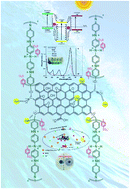Highly efficient, bioactive, and bifunctional sorbent p–n–p visible light heterogeneous photocatalyst utilizing ultra-fine ZnS nanoparticles embedded in a polymeric nanocomposite
Abstract
This study reports the successful synthesis of a ZnS@GO@Pani polymeric nanocomposite (NC) via chemical polymerization. The product was used for simultaneous photocatalytic degradation–adsorption of malachite green (MG), a carcinogenic and widely used dye. The physicochemical properties of the prepared NC were characterized by various techniques. Morphological and XRD results confirmed the fine size of ZnS nanoparticles (NPs) with an approximate mean size of 5 nm, uniformly distributed within the polymeric matrix. For comparative purposes, photocatalytic dye degradation–adsorption of this nanohybrid was explored both in the dark and under natural light. It was observed that 0.1 g of the ternary NC in MG aqueous solution (20 ppm) leads to dye adsorption within 15 minutes with an efficiency of 70% under dark conditions. Also, MG removal efficiency of up to 90% was achieved in 15 minutes under natural light owing to integrated photocatalytic degradation–adsorption mechanisms. Adsorption isotherm studies were performed considering Langmuir, Freundlich, Temkin, and Dubinin–Radushkevich (D–R) models. The results showed that the Freundlich isotherm with R2 = 0.988 is well consistent with the experimental data. Integrated photocatalytic degradation–adsorption kinetics were modeled with pseudo-first-order (PFO) and pseudo-second-order (PSO) models where PSO with R2 = 0.999 best fitted the data, implying the predominant role of chemical adsorption in the dye removal process. Antibacterial tests revealed superior antibacterial activity of the prepared ZnS@GO@Pani NC against both Gram-negative and Gram-positive bacteria, demonstrating the remarkable synergistic effect of ZnS NPs embedded in the GO@Pani matrix. Accordingly, the prepared NC could be regarded as a promising candidate for wastewater treatment applications. The leaching and regeneration studies also confirmed that the prepared NC is a non-toxic dye removal agent with good reusability.



 Please wait while we load your content...
Please wait while we load your content...